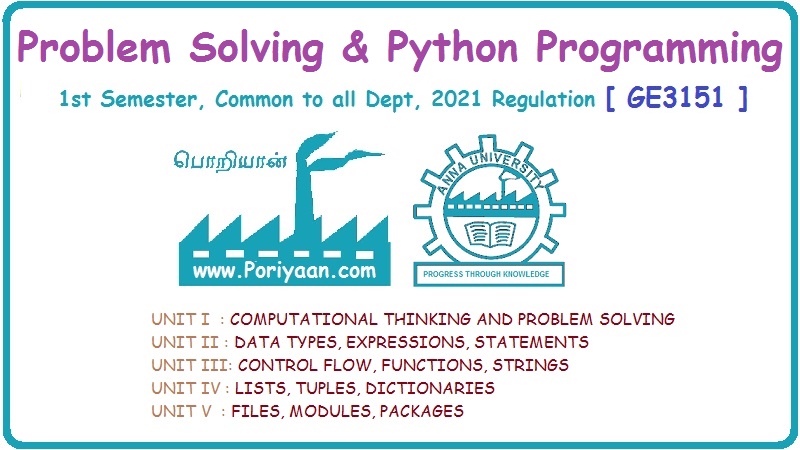Problem Solving and Python Programming: UNIT I: Computational Thinking and Problem Solving
Algorithms
Definition, Examples, Characteristics
An algorithm is a finite set of instructions for performing a particular task. The instructions are nothing but the statements in simple English language.
Algorithms AU
: May-19, Dec.-19, Marks 8
Definition
of Algorithm : An algorithm is a finite set of
instructions for performing a particular task. The instructions are nothing but
the statements in simple English language.
Example
:
Let
us take a very simple example of an algorithm which adds the two numbers and
store the result in a third variable.
Step
1:
Start
Step
2:
Read the first number in variable 'a'
Step
3:
Read the second number in variable 'b'
Step
4:
Perform the addition of both the numbers and store the result in variable 'c'.
Step
5:
Print the value of 'c' as a result of addition.
Step
6:
Stop.
1. Characteristics of Algorithm
1.
Each algorithm is supplied with zero or more inputs.
2.
Each algorithm must produce at least one output
3.
Each algorithm should have definiteness i.e. each instruction must be
clear and unambiguous.
4.
Each algorithm should have finiteness i.e. if we trace out the
instructions of an algorithm, then for all cases the algorithm will terminate
after finite number of steps.
Each
algorithm should have effectiveness i.e. every instruction must be sufficiently
basic that it can in principal be carried out by a person using only pencil and
paper. Moreover each instruction of an algorithm must also be feasible.
Example
1.3.1 Find the area of a circle of radius r.
Solution
:
Inputs
to the algorithm :
Radius
r of the Circle.
Expected
output :
Area
of the Circle
Algorithm
:
Step
1:
Start
Step
2:
Read input the Radius r of the Circle
Step
3:
Area ← PI*r*r // calculation of area
Step
4: Print
Area
Step
5:
Stop
Example
1.3.2 An algorithm to calculate even numbers between 0
and 99.
Solution
:
Step
1 :
Start
Step
2:
Read n or Initialize n = 99
Step
3:
Initialize i = 2
Step
4:
If i < = n, then goto step 5 else goto step 7
Step
5:
If i%2 = 0, then goto step 5.1,5.2 else goto step 6
Step 5.1: Print i
Step 5.2: i = I + 1 goto
step 4
Step
6:
i = I + 1 goto step 4
Step
7:
Stop
Example
1.3.3 Outline the algorithm for displaying the first n
odd numbers.
AU
: May-19, Marks 8
Example
1.3.2 An algorithm to calculate even numbers between 0 and
Solution
:
Step
1 :
Start
Step
2:
Read n
Step
3: Initialize
i = 1
Step
4:
If i<=n then goto step 5 else goto step 9
Step
5:
if i%2!=0 then goto step 6 else goto step 7
Step
6:
Print i
i
= i + 1
Step
7:
i = i + 1
Step
8:
goto step 4
Step
9:
stop
Example
1.3.4 Write an algorithm to find the minimum number in
a given list of elements.
AU
: Dec.-19, Marks 2
Solution
:
Step
1:
start
Step
2:
Read n numbers and store them in a list.
Step
3: set
count =1
Step
4:
min = list[count]
Step
5:
while(not end of the list) then goto step 6 otherwise goto step 8
Step
6:
if(list[count]<min)
min
= list[count]
count
= count+1
Step
7:
goto step 5
Step
8:
if the complete list is scanned then display the value present in the min
variable as the minimum number in the list.
Review Question
1. What is an algorithm? Summarize the characteristics of a good
algorithm.
AU : May-19, Marks 8
Problem Solving and Python Programming: UNIT I: Computational Thinking and Problem Solving : Tag: Engineering Python : Definition, Examples, Characteristics - Algorithms
Related Topics
Related Subjects
Problem Solving and Python Programming
GE3151 1st Semester | 2021 Regulation | 1st Semester Common to all Dept 2021 Regulation
